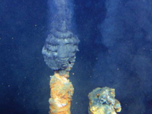Thirty years of ocean ridge exploration: diversity and localisation of hydrothermal systems.
In 1978, the first hot (350 °C) hydrothermal resources were discovered in the great ocean deep on the East Pacific volcanic ridge. Through this spectacular discovery, scientists prove for the first time that a significant part of Earth's heat is extracted through heated seawater. We currently estimate that 25 % of Earth's heat is evacuated through these fluids.
Biological and mineral diversity
The implications of this discovery rapidly exceeded the fields of geophysics and plate tectonics. The chemical energy contained in the fluids develops intense microbial activity and specific and original animal communities who feed here thanks to geothermal energy.
Whatsmore, the metals extracted from the depths of the terrestrial crust and mantle accumulate to form metallic sulphide clusters which represent a potential mineral resource. In certain contexts, rocks from the terrestrial mantle rise to the outcrop. The fluids resulting from the reaction of seawater with these rocks are very rich in hydrogen, methane and heavy hydrocarbons.
Subsea volcanoes and ridges: zones rich in hydrothermal resources
In 35 years of exploration, scientists have discovered 90 active hydrothermal fields.
The resources are located mainly on oceanic ridges on the border the plates where volcanic and tectonic activity is the most intense. Ridges are where the oceanic crust forms and where plate rifting constitutes the Earth's crust.
After the discovery of these hydrothermal fields on rapid ridges (rifting of between 6 and 18 cm/year), exploration in the 80's and 90's led to the discovery of hot resources on slow ridges rifting at speeds of less than 6cm/year. At the end of the 80's and during the 90's, exploration discovered that hydrothermal resources are also frequent along volcanic ridges located to the rear of deep trenches (in particular in the west Pacific to the rear of the Mariana and Tonga Trenches). Certain inter-plate volcanoes, located, not on the border of plates like ridges but inside, also present underwater hydrothermal activity.
Around all sources, scientists have observed microbial fauna and flora associated with hydrothermal fluid seeps. To date, 500 species of animal have been identified in these habitats.
All underwater volcanoes have shown to be associated with intense hydrothermal activity. A great part of the 60000 km of ridges around the world remains to be explored, research is continuing on the Atlantic, Indian and Pacific ridges. To better understand the processes, interactions and temporal variations of hydrothermal activity and its incidence on biological activity, many other studies are being conducted on specific projects.
Hydrothermal systems: when rocks interact with the ocean
We now know that the composition of fluids, hydrothermal precipitates and the animal populations associated with sources varies tremendously.
This diversity depends mainly on two parameters : pressure and the nature of rocks interacting with seawater.
Pressure affects the boiling temperature of fluids. Yet, hydrothermal sources are present from the coastal zone down to 4100 m. If the temperature of fluids exceeds that of seawater, the fluids will be more (brine) or less saltier (condensed vapour) than seawater. At 3000 metres for example, the boiling temperature of seawater is more than 400 °C. The nature of rocks leached during hydrothermal circulation is the second factor influencing the composition of hydrothermal fluids and deposits. Hydrothermal fluids and deposits emanating from the interaction between seawater and basalt lava (poor in silica), rhyolitic lava (rich in silica), sediment and ultrabasic rocks from the mantle have extremely diversified compositions.
For a period of around twenty years, the countries mastering the technology of manned submersibles (France, USA, Japan, Russia, Canada) had privileged access to the study of hydrothermal systems. The arrival of remotely-operated vehicles widened this group to Germany, England, China and South Korea.
30 years of Franco-Russian cooperation
There has been strong cooperation between France and Russia for more than 30 years in the exploration of and insight into the Mid-Atlantic Ridge, where the American and African plates separate. Since 1969, several joint expeditions have taken place on board Russian and French ships.
The aim of this cooperation is to improve our knowledge of the deep ocean and its relations with the inside of the globe, identify potential mineral resources and apprehend the ecology of hydrothermal systems. This expertise will be essential for sustainable exploitation of deep mineral resources and environmental conservation.
During the 70's and 80's, cooperation focalized on the study of volcanic rock. The objective was to understand the mechanisms of mantle fusion producing lava, themselves the source of the oceanic crust. Then, at the beginning of the 90's, research steered towards the study of the mechanisms of chemical transfer through hydrothermal circulation. More specifically, French and Russian scientists became more involved in the transfer of metals and their accumulation in the form of polymetallic sulphide deposits which form a potential mineral resource. Finally, the opening-up of cooperation to hydrothermal systems has widened the field of research to biodiversity studies and the study of extremophile bacteria of the great deep.
Many Russian organisms were involved in the Serpentine expedition : the Vernadsky Institute in Moscow (rock geochemistry), the Institute of Geology of Mineral Resources of Moscow (study of polymetallic mineralisation), the Shirshov Institute of Moscow (biology), the Winogradsky Institute of Microbiology of Moscow (microbiology), the Institute of Oceanic Geology of Saint Petersburg (geochemistry of water and hydrothermal precipitates).









